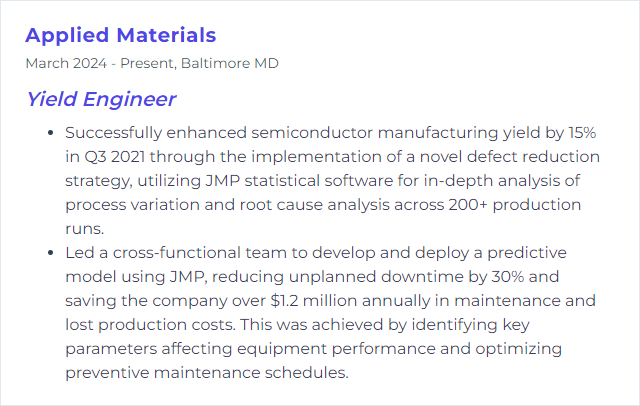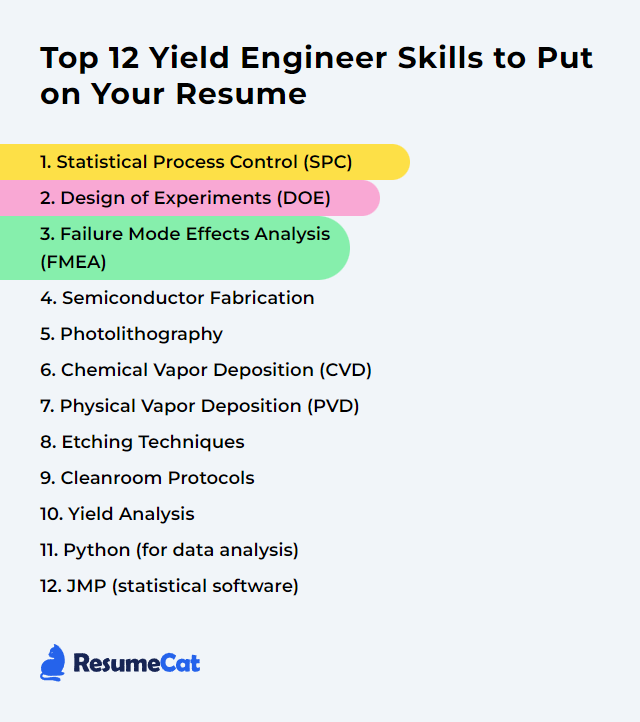Top 12 Yield Engineer Skills to Put on Your Resume
In today's competitive job market, standing out as a Yield Engineer means showing a crisp, relevant stack of skills that prove you can squeeze defects out of processes and push good parts through. The right mix on your resume signals technical depth, a feel for factories, and the grit to chase root causes until they stop biting.
Yield Engineer Skills
- Statistical Process Control (SPC)
- Design of Experiments (DOE)
- Failure Mode Effects Analysis (FMEA)
- Semiconductor Fabrication
- Photolithography
- Chemical Vapor Deposition (CVD)
- Physical Vapor Deposition (PVD)
- Etching Techniques
- Cleanroom Protocols
- Yield Analysis
- Python (for data analysis)
- JMP (statistical software)
1. Statistical Process Control (SPC)
Statistical Process Control (SPC) is the disciplined use of charts, rules, and data to keep a process behaving. It helps you see drift early, clamp variation, and hold quality steady while the line keeps moving.
Why It's Important
For a Yield Engineer, SPC is the frontline alarm and the steering wheel. It flags special causes before they snowball, stabilizes outputs, and trims cost by catching trouble upstream.
How to Improve Statistical Process Control (SPC) Skills
To sharpen SPC, focus on accuracy, speed, and signal clarity.
Strengthen data foundations: Calibrate sensors, validate historians, and run Measurement System Analysis (GR&R, bias, linearity) so your charts aren’t built on sand.
Go real-time: Stream data into live control charts with alerting. Shorten the loop from signal to correction.
Use the right rules: Apply Western Electric/Nelson rules, tailor control limits by product family, and separate startup from steady-state windows.
Think multivariate: Add multivariate SPC (PCA, T² charts) when single metrics hide coupled shifts.
Close the loop: Tie out-of-control action plans to standard work. Audit effectiveness, then adjust limits and playbooks.
Blend predictive models: Layer in anomaly detection and predictive quality to see excursions before they crest.
Coach the floor: Train operators and technicians; situational judgment beats pretty charts that nobody trusts.
Done right, SPC becomes muscle memory across people, tools, and processes.
How to Display Statistical Process Control (SPC) Skills on Your Resume

2. Design of Experiments (DOE)
DOE is the structured way to learn fast. It maps factors to responses with efficiency, tests interactions you’d otherwise miss, and trims the guesswork from process tuning.
Why It's Important
Because yield lives in the interactions. DOE finds the levers, quantifies trade-offs, and points to robust settings that hold under noise.
How to Improve Design of Experiments (DOE) Skills
Set crisp objectives: Define the question, responses, practical ranges, and constraints. No fuzzy scope.
Use the right design: Full/fractional factorials to screen, response surface for optimization, split-plot when hard-to-change factors exist, definitive screening for efficiency.
Respect fundamentals: Randomization, blocking, replication. Check alias structures and power before you run.
Pilot first: Dry runs catch tooling limits, metrology issues, and setup pitfalls.
Analyze thoughtfully: Model hierarchy, interaction terms, lack-of-fit tests, residual checks. Don’t chase noise.
Optimize for robustness: Explore design space under noise factors; target flat optima, not brittle peaks.
Iterate: Sequential experimentation beats one giant bet.
Document and standardize: Roll winning settings into control plans and training.
How to Display Design of Experiments (DOE) Skills on Your Resume
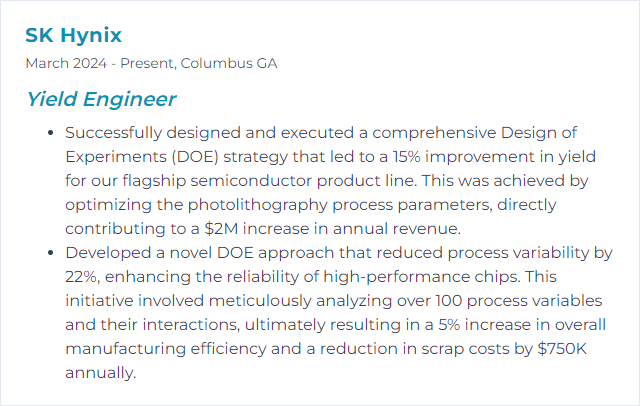
3. Failure Mode Effects Analysis (FMEA)
FMEA is the systematic hunt for what can go wrong, how bad it gets, how often it bites, and how well you catch it. Then you fix the worst, first.
Why It's Important
It prevents defects before they’re born, hardens processes, and pushes yield up by choking off high-risk failure paths.
How to Improve Failure Mode Effects Analysis (FMEA) Skills
Map the process clearly: Use current process flows and boundary diagrams so nothing hides between steps.
Prioritize with modern criteria: Apply AIAG-VDA FMEA concepts and Action Priority (AP). Severity, Occurrence, and Detection still matter—AP guides where action is mandatory versus desirable.
Go after root causes: 5 Whys, Ishikawa, fault-tree logic. Verify causes with data before assigning actions.
Tie actions to controls: Prevention first, then detection. Update control plans, work instructions, and training.
Measure impact: Re-score after actions. Track defect rates, escapes, and yield lift.
Keep it alive: Treat it as a living file. Refresh after design or process changes, supplier shifts, or field returns.
Build cross-functional muscle: Manufacturing, quality, design, maintenance—different eyes spot different traps.
Use purpose-built tools: Standard templates, structured reviews, and audit trails keep rigor high.
How to Display Failure Mode Effects Analysis (FMEA) Skills on Your Resume
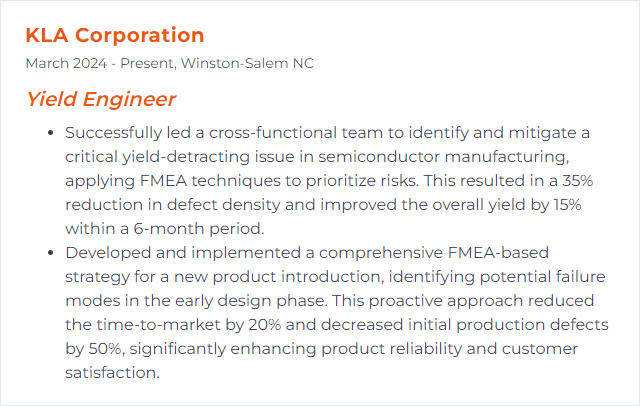
4. Semiconductor Fabrication
Fabrication stacks films, patterns features, and sculpts devices across dozens of intricate steps. Yield Engineering stitches this all together—guarding process windows, hammering defects, and aligning equipment, materials, and designs.
Why It's Important
Every lost die is cost, and every excursion ripples through lots. Better fab control lifts output, consistency, and reliability in one stroke.
How to Improve Semiconductor Fabrication Skills
Stabilize core modules: Litho, etch, deposition, implant, clean—tune parameters to shrink variation and lock in margins.
Drive defect learning: Inline inspection, SEM review, pareto by defect class, and fast containment. Shorten time-to-root-cause.
Maintain proactively: Predictive maintenance on critical tools, chamber matching, golden recipes, and post-PM re-qualifications.
Exploit data: Wafer maps, spatial analytics, excursion clustering, and lots-to-lots correlation to catch subtle drifts.
Mind the node: For advanced nodes, manage EUV-specific issues (stochastic defects, CDU, overlay) and tighten contamination control.
Share knowledge: Bake lessons into standards, training, and design-for-manufacturability feedback loops.
How to Display Semiconductor Fabrication Skills on Your Resume
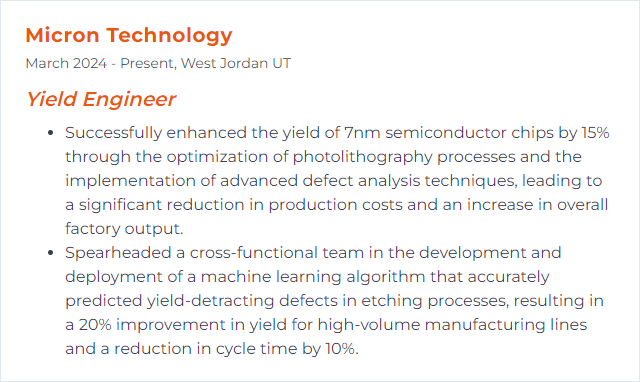
5. Photolithography
Photolithography transfers mask intent to silicon with brutal precision. Resist behavior, exposure dose, focus, and post-exposure bakes all matter. Miss by a hair and yield pays for it.
Why It's Important
Patterns define performance. Line edge roughness, overlay, and critical dimension control set the ceiling on device quality and throughput.
How to Improve Photolithography Skills
Dial in the recipe: Optimize resist thickness, soft bake, dose/focus matrices, develop time, and PEB to sharpen fidelity.
Keep tools tight: Regular calibration of steppers/scanners, stage accuracy checks, illumination uniformity, and alignment system health.
Reduce defects ruthlessly: Cleaner tracks, tuned spin/rinse/dry, particle control at coater/developer, and disciplined reticle handling.
Apply RET intelligently: OPC, phase-shift masks, SRAF, multiple patterning, and source-mask optimization when margins thin.
Measure and respond: CD-SEM, scatterometry, and overlay metrology with feedback to exposure and focus control in real time.
Align with design: DFM rules and early design reviews prevent unprintable geometries and fragile hotspots.
For EUV: Watch stochastic defects, resist sensitivity, mask pellicle issues, and flare; tighten dose control.
How to Display Photolithography Skills on Your Resume

6. Chemical Vapor Deposition (CVD)
CVD grows films from reactive gases onto hot surfaces—conformally, controllably, and repeatably when tuned well. Thickness, stoichiometry, and stress are your levers.
Why It's Important
Film quality and uniformity directly feed device performance and reliability. Better CVD equals cleaner interfaces, tighter specs, and fewer latent failures.
How to Improve Chemical Vapor Deposition (CVD) Skills
Tame gas delivery: Balance precursor and carrier flows, stabilize MFCs, and design showerheads for uniform distribution.
Control temperature: Flatten wafer-to-wafer and across-wafer gradients; recalibrate pyrometers and tune heaters for uniform kinetics.
Set the right pressure: Optimize pressure to trade off step coverage, reaction rates, and film density; confirm with uniformity maps.
Prepare substrates: Clean, activate surfaces, and minimize native oxides so films anchor well and defects don’t seed.
Maintain the chamber: Routine liner changes, leak checks, and precursor purity audits to hold films steady over time.
Watch in real time: Endpoint and in-situ sensors (QCM, OES, IR) to catch drift mid-run and auto-correct.
Simulate before you spend: Use CFD and kinetics modeling to test hypotheses and shrink DOE scope. Consider ALD when atomic-level control is required.
How to Display Chemical Vapor Deposition (CVD) Skills on Your Resume

7. Physical Vapor Deposition (PVD)
PVD ejects atoms from a target and lands them onto a surface. Sputter, evaporate, repeat. Great for metals, barriers, and adhesion layers—when the process is clean and stable.
Why It's Important
Uniform films and clean interfaces mean fewer opens, better conductivity, and happier downstream steps. Yield rises when variation falls.
How to Improve Physical Vapor Deposition (PVD) Skills
Prep surfaces well: Degas, plasma clean, and manage roughness so adhesion sticks and voids don’t form.
Hold key parameters: Deposition rate, substrate temperature, pressure, and power density all move microstructure and stress—lock them in.
Monitor in situ: Quartz crystal microbalance, optical monitoring, and plasma diagnostics to steer thickness and composition.
Use high-purity inputs: Targets, gases, and fixtures free of contaminants keep defects low.
Service the tool: Regular target conditioning, shutter inspections, and calibration keep runs consistent.
Simulate and validate: Model angular distributions and shadowing for complex topography; verify step coverage with cross-sections.
How to Display Physical Vapor Deposition (PVD) Skills on Your Resume

8. Etching Techniques
Etching shapes devices by removing what doesn’t belong. Wet chemistries carve broadly; plasmas chisel with precision. Selectivity, anisotropy, and damage control are the trifecta.
Why It's Important
Poor etches warp CDs, gouge profiles, or scar surfaces. Good etches stay sharp, spare masks and underlayers, and leave surfaces clean for the next act.
How to Improve Etching Techniques Skills
Engineer the recipe: Tune power, pressure, gas ratios, and temperature for target selectivity and profile control. Use DOE to map trade-offs.
Pick the right masks: Hard masks vs. resists—match resistance to chemistry and aspect ratio demands.
Calibrate and maintain: Verify MFCs, RF delivery, chamber cleanliness, and seasoning steps to steady the process.
Use in-situ endpoints: Optical emission, interferometry, or mass spec to stop at the right moment and reduce over-etch damage.
Protect the surface: Manage passivation layers and post-etch cleans to limit residue and roughness.
Control contamination: Uphold ISO 14644 cleanroom discipline; particles and metals skew profiles and kill yield.
Advance the toolbox: For extreme precision, consider Atomic Layer Etching to remove a few angstroms per cycle.
How to Display Etching Techniques Skills on Your Resume
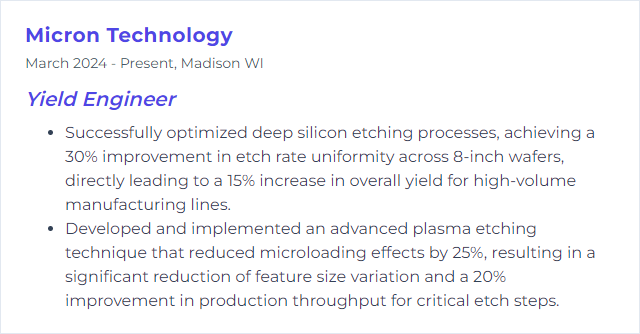
9. Cleanroom Protocols
Cleanrooms are about discipline. Gown right, move right, handle right, and keep air and surfaces free from the tiny culprits that sabotage devices.
Why It's Important
Particles, ions, and films cause killer defects and latent headaches. Protocols keep contamination out of the process and yield on the rails.
How to Improve Cleanroom Protocols Skills
Train relentlessly: Behavior, gowning, tool etiquette, and quick refreshers after any nonconformance.
Audit and correct: Frequent walk-throughs, swab tests, and adherence checks with rapid countermeasures.
Upgrade materials and gear: Low-shedding garments, proper wipes and solvents, and equipment that minimizes particle generation.
Design the flow: Layout that reduces cross-traffic, aligns with airflow, and isolates dirty steps from sensitive ones.
Control access: Restrict entry, enforce step-by-step gowning, and log compliance.
Maintain the environment: HEPA/ULPA filter upkeep, HVAC tuning, and strict cleaning schedules aligned to ISO 14644.
Monitor continuously: Real-time counts for particles, plus temperature and humidity tracking with tight alarms.
Listen and improve: Encourage operators to flag issues; the best fixes often start with a quick comment at the tool.
How to Display Cleanroom Protocols Skills on Your Resume
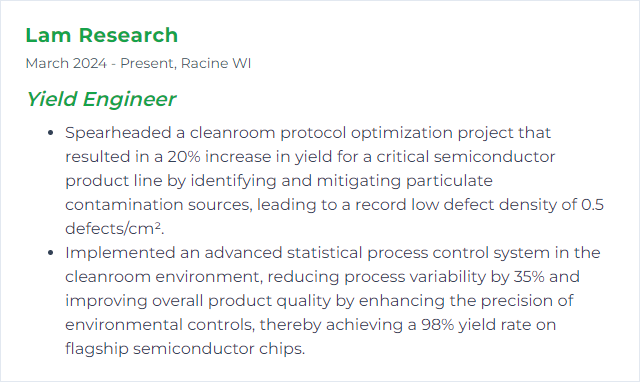
10. Yield Analysis
Yield Analysis turns raw factory data into decisions. It hunts patterns, links causes to effects, and turns one-off fixes into systemic lift.
Why It's Important
Because you can’t fix what you can’t see. Good analysis exposes the few vital drivers among the many trivial ones and pays back in throughput and cost.
How to Improve Yield Analysis Skills
Instrument the flow: Collect complete, time-synced data across tools, lots, wafers, dies, and tests. Bad inputs, bad insights.
Use the right analytics: Wafer map clustering, excursion detection, part average testing, SPC, and robust outlier removal before modeling.
Model with care: GLMs, tree ensembles, GAMs, and survival models for reliability—always validate on fresh data and watch for leakage.
Close the feedback loop: Convert insights to recipe changes, maintenance tasks, or supplier actions. Track post-change deltas.
Partner upstream and down: Collaborate with design, packaging, and suppliers to fix systemic issues at their source.
Standardize reviews: Regular yield deep-dives, paretos, and drill-downs that trigger targeted countermeasures.
How to Display Yield Analysis Skills on Your Resume
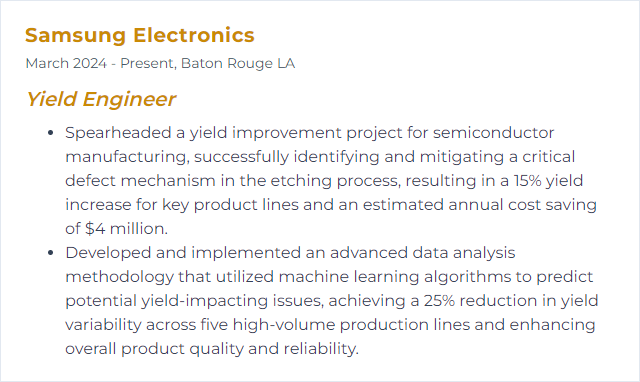
11. Python (for data analysis)
Python is the workhorse for parsing logs, wrangling datasets, modeling patterns, and visualizing what matters. It scales from quick checks to production pipelines.
Why It's Important
It shortens time-to-insight. With rich libraries and a vast ecosystem, you can move from raw data to action without friction.
How to Improve Python (for data analysis) Skills
Own the core stack: pandas or polars for frames, NumPy for numerics, SciPy for stats, matplotlib/seaborn/plotly for visuals.
Level up modeling: scikit-learn for classic ML, XGBoost/LightGBM for tabular punch, and statsmodels for explainable fits.
Handle scale: Dask or PySpark for big data; Arrow and Parquet for fast IO; vectorized ops over loops.
Automate the boring: Build scripts and notebooks that parameterize runs, log versions, and export clean reports.
Engineer reliability: Tests, linting, virtual environments, and version control so analyses are repeatable and shareable.
Practice on real problems: Work wafer maps, tool drifts, and test-yield splits until patterns jump out at first glance.
How to Display Python (for data analysis) Skills on Your Resume

12. JMP (statistical software)
JMP blends interactive visuals with capable statistics. It’s fast for DOE, SPC, screening, and ad hoc dives—perfect for manufacturing data where speed and clarity count.
Why It's Important
It lowers the barrier from question to insight. Drag, drop, and drill until the signal is obvious, then package it cleanly for decisions.
How to Improve JMP (statistical software) Skills
Master the essentials: Graph Builder, Distribution, Fit Y by X, and Control Chart Builder—use them daily.
Exploit DOE: Build screening and optimization designs, then use the Profiler to explore trade-offs and robustness.
Standardize workflows: Create reusable scripts with JSL to automate recurring analyses and reports.
Explore advanced platforms: Process Screening, Variability/Gauge Studies, and Wafer Maps for spatial patterns.
Tell a clear story: Use data tables, highlights, and dashboards so stakeholders see the “so what” instantly.
Stay current: New releases often add serious capability—upgrade and fold features into your toolkit.
How to Display JMP (statistical software) Skills on Your Resume
